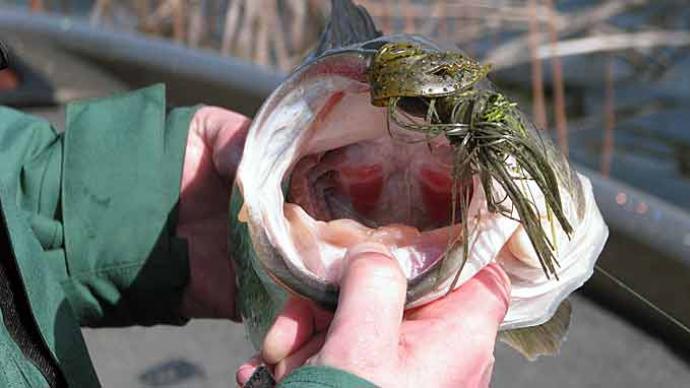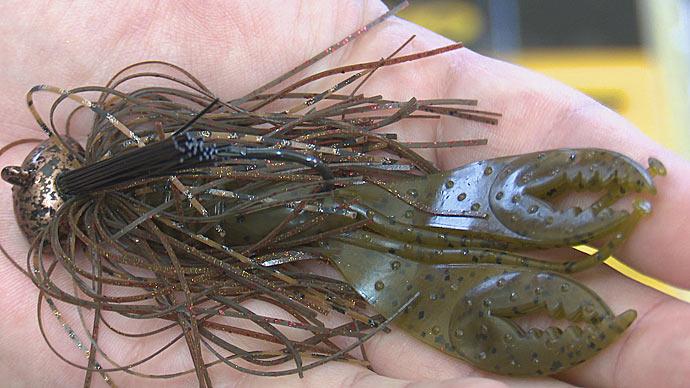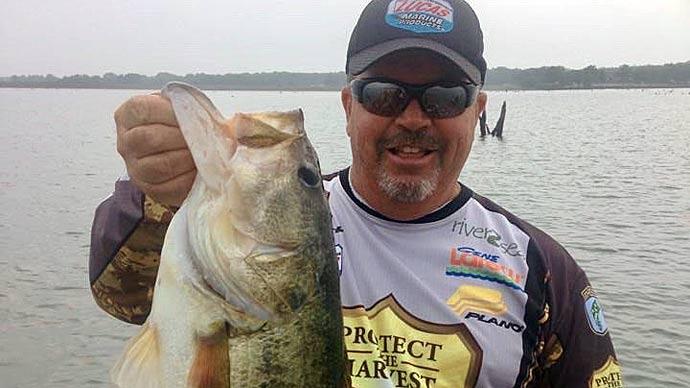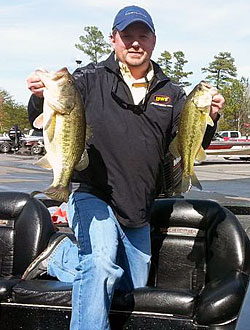
As far as lure design is concerned, bass jigs are pretty basic, consisting of a leadhead, hook, skirt, and trailer. But many anglers read too far into that simplicity, blaming complexity when they do not get many bites with one in short order. It can cause anglers to shy away from jigs.
Doing so is unfortunate. Jigs are one of the most versatile lures in the world of bass fishing. Better yet, jigs produce big bass year-round. That’s why professional anglers, Denny Brauer being one, have built lasting careers by almost exclusively using jigs.
There are a hundred ways to fish jigs, which come in hundreds of combinations of sizes, colors, and styles. That can be intimidating, and there’s no way to learn them all, and you don’t need to. When you first fish one, assembling a simple attack is more important — from choosing one to using it. Here’s how you can learn to love jig fishing.
Choosing a jig
Each of the hundreds of jigs you’ll find hanging at a tackle shop was designed with a purpose. Finding the right one is a matter of matching attributes to fishing conditions.
First, look at the head design. The most popular head design is called an Arkie. The head is broad in the front and tapers toward the hook shank. It’s suitable for flipping and casting; its broader base also makes it suitable for skipping under docks and overhanging trees. Pointed heads are popular, too, especially with anglers who fish thick and matted grass. Shaped like a bullet sinker, it slips through the smallest hole. It lacks a flat surface, so it’s a poor skipper and easily wedged in crevices, so avoid throwing one around broken rock and wood. Football head jigs work best on deep structure. Its wide stance keeps it from catching in rocks and makes the jig waddle across the bottom with each pull. Most of its weight is under the line tie, which keeps the hook up.
Jigs are poured in many weights, but these three weights will get you started. A ¼-ounce jig is best when the water is cold because it slowly sinks. A 3/8-ounce jig is the most versatile, from pitching docks to probing outside weedlines as deep as 15 feet. This is the weight to rig 90 percent of the time. The 1/2-ounce jig is considered the big gun. This size busts through grass and falls fast enough to trigger reaction bites. It also is easier to keep on deep structure.
Look at the line tie next. Some are parallel with the hook, while others are perpendicular. Parallel ties help a jig skip, and flat ties pull through cover better.
Nearly every jig uses a bristle weed guard. It works great thwarting hang-ups, but you can increase hook-ups by removing a few bristles. Don’t shorten them; that just makes them stiffer. Y-guards, made of thin plastic shaped like the name, are less weedless than a bristle guard. Some jigs have a single flexible wire that stops before the hook point. It’s basically like not having a guard, so fish jigs are equipped with one around sparse cover, such as sand with a bit of grass or large rocks.
You’ll want a big hook. Typically that’s a 3/0 in a ¼-ounce jig, 4/0 in a 3/8-ounce jig, and a 5/0-hook in a 1/2-ounce one. These sizes give you enough gap for a trailer and a big bass.
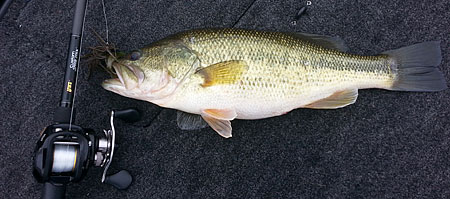
An entire website could be dedicated to choosing jig colors. Your best bet when starting out is to select a color or two and put the rest of your time and efforts into generating bites. In clear water, it’s hard to beat a brown, watermelon, or green pumpkin jig. In stained water, Texas craw and black are good colors to throw.
If you can’t find an assembled jig that you like, you can build your own. You can make this process as simple or complex as you like.
First, you’ll need a jig head. Many online stores that sell tackle-building supplies offer a variety of poured heads. You can pick the weight, hook size, and even if it's painted or bare lead. You also can find molds, lead ingots, melting pots, and hooks if you’re interested in pouring your own. If it’s your first time pouring lead, follow all the safety notices to the letter, especially proper ventilation. Molten lead and its fumes are not to be taken lightly.
You also might need some weed guards — some jig heads have a hole where you can insert them. A dab of epoxy will keep them in place. Rattles are also available, making your jig more attractive to bass in heavy cover or dirty water. Some rattles clip on the hook shank. Another option uses a collar and short, flexible rubber arms to attach one or two rattles. These allow the rattles to move freely, adding more noise when they bump rocks, wood, or the bottom.
The final component is the skirt. Supply shops sell them tied in more color combinations than you’ll find in traditional tackle shops. Even more, colors are offered in skirt material tabs. It takes two, three, or more tabs to make a skirt, depending on how full you want. The tabs can be cut, making it easy to spike a skirt with a couple of strands of a different color.
You’ll need a skirt-making tool. Load a collar on the tool. Once the collar is open, thread the tabs through, making both sides equal in length. Release the collar from the tool and snip the ends of the tabs, freeing the strands. It’s ready to thread on a jig, spinnerbait, or buzzbait.
Rigging a jig
Trailers are an essential part of jig fishing. They add bulk, give jigs an irresistible profile, and affect the fall. Some diehards still use pork-rind trailers on their jigs, but most anglers today choose soft-plastic ones, which are sold in more shapes, sizes, and colors. While they may not be as durable as pork, plastic chunks are easier to get on the hook and don’t dry out.
Trailers with big, flat paddles will cause a jig to glide as it sinks. That can trigger bites around docks and laydowns. It can be OK in thick grass, too, but make sure you’re reaching the bottom and the trailer is not steering your jig into a tangle partway down. That goes for fishing around brush piles, too. For thicker cover, choose a trailer with narrow paddles. Twin-tail grubs also make good trailers but are best for when you’re moving your jig, such as swimming it around shallow cover or aggressively hopping it across the submerged structure.
There are two routes to selecting your trailer color: match or contrast your jig. Matching is best in clear water with sparse cover, where bass can easily find your jig. The clear water will have them on guard, so you want a realistic offering. Green pumpkin, watermelon, and black are good choices. A bright-colored trailer — such as electric blue or chartreuse — can help bass find your jig in heavy cover.
Whichever style trailer you choose, thread it instead of running it on the hook like a pork chunk. A drop of glue before you push it against the lead will lock it in place. This rigging will make your jig glide and add bulk under the skirt, not to mention make the trailer last longer.
Where to first fish a jig
There are a million places to fish a jig. Bass will eat them so shallow that you must cast them onto the bank and drag your jig into the water. Also, bass will crush one that’s bounced off brush and rock in 40 feet of water. You can swim a jig just under the surface, reeling it right along, and dead stick it in heavy cover. All generate bites at some time, but you’ll only catch a boatload of frustration if you try to master them all at once. Instead, add another technique after one is mastered.
So which should you try first? Casting, pitching, and flipping jigs to visible targets are the choice. All anglers enjoy casting at something, whether it’s a dock, weedline, or laydown, and a jig is perfect for this. Fishing a jig this way isn’t difficult. Cast it as close as possible to the cover, then make sure it hits the bottom. That can be important when fishing around heavy grass. Sometimes a lighter jig can catch in the grass. The jig is only halfway down when you think you’re on the bottom. If this is the case, try a heavier jig, which can bust through to the bottom.

Most bass will bite a jig before it reaches the bottom. You can try sliding it along the bottom with a couple of pulls or hops if one doesn't. Sometimes, especially in heavy cover, it can be good to shake it in place, which helps bass find it. But don’t spend forever. It’s a rare day when you have to dead-stick a jig for an extended time. Most days, fishing more targets is the more productive approach.
You do need to adjust your expectations. Jigs don’t generate as many bites as a drop shot, Senko, or shakey head. But the bass you catch on them are almost always bigger, making up for any fishless time.
The bite
A jig bite can be hard to detect, and the better feel you develop for them, the more bass you will catch. The best jig bite is a solid tap you feel up your arm. It happens when bass are aggressive, inhaling the jig so hard that it bounces off the roof or back of their mouth. Knowing that a bass has it and you can set the hook hard is a great feeling. But bass anglers in the country's northern reaches can attest to what might happen next. The northern pike will hit a jig just as hard. You’ll know you had one when you set the hook, and all you get back is line, the pike’s teeth sawing off your jig.
Bass also will grab your jig and slowly swim with it. This happens most often while fishing docks. You’ll skip your jig under a pontoon boat or floating dock, and by the time you engage the reel, the jig is swimming back at you. It can be hard to hook these bass. Your best bet is to watch the line and never let the jig fall on an utterly slack line. Let your jig pull line freely, but keep extra slack out by managing the spool with your thumb. Then strike as soon as a bass does.
Then there is the “mush” bite. The jig will feel a little heavier, or there will be some resistance when you try to move it. It could be a bass, or it could be a clump of grass, stick, or something else the jig has caught. The only way to know for sure is to set the hook. This fools even the best jig anglers, so don’t hesitate to set the hook. As the old saying goes, “Hooksets are free!”
Pay attention to the depth of water where your jig is falling. If it is taking a longer — or shorter — amount of time to reach the bottom, set the hook. It could be a bass hitting it halfway down and sitting still or grabbing it and swimming away from you with it.
You can cast jigs on either spinning or casting rods, but it’s hard to beat a 7- to 8-foot heavy action casting rod, high-speed reel, and 15- to 20-pound test line. But regardless of what you’re using or when it comes, that first bite will hook you on jig fishing for life.


